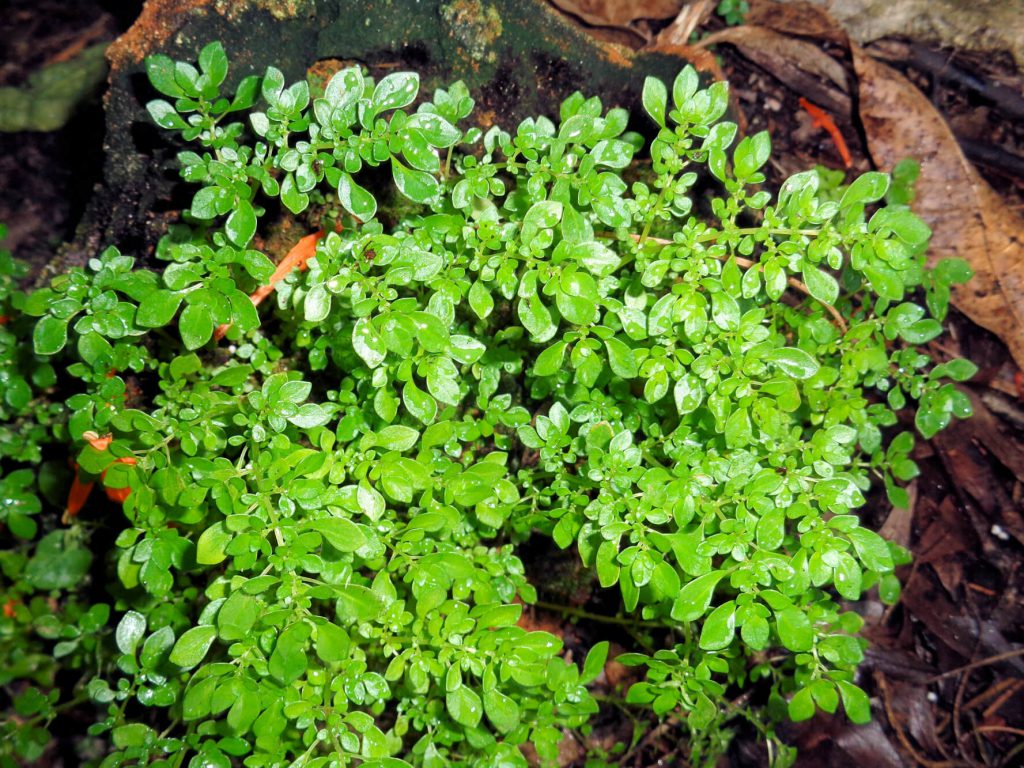
There is a subtropical/tropical plant in our area that in some parts of the horticultural world is a terrarium plant, a greenhouse resident or coveted house plant. Unfortunately, in many parts of central and southern Florida, the growing conditions for this native from tropical America are so favorable that it is now a weedy plant. The artillery plant (or artillery weed, depending on who you ask) is its name, and growing in shady moist nooks and crannies is its game. Although there is a variegated cultivar kept as an ornamental, the artillery plant does not have a fan club!
You may have seen the artillery plant hiding in plain sight growing amongst some shade-loving plants or popping up amongst stones and hard to get at rubble, pavement cracks, and gravely areas. Pilea microphylla is a pleasing green color with small leaves on brittle herbaceous branches up to twelves inches tall and spreading to almost twenty-four inches wide. The flowers on this plant are tiny, green and considered inconspicuous. However, the male flowers are known to shoot their pollen out in an explosive manner. This smoke-like puff of pollen, easily seen (with patience) by the naked eye, is where the “artillery plant” gets its name. In addition to the artillery plant being very easy to root from stem segments, the seeds go everywhere and thus this plant expands its territory.
In commercial nursery and greenhouse settings, the artillery plant is a problem weed. Growing on weed mats and in potted plants, this plant quickly colonizes areas often hard to get at with hand removal or chemical control. Artillery plants are very resistant to some herbicides, and hand-pulling may be the best strategy for the home gardener. A good effort weeding by hand, coupled with two-inches of organic mulch, will generally suppress this weed. In a shady part of my yard, artillery plants have made a small foothold. Every time I think that I have brought them under control, I see a new little patch developing. I believe that I accidently brought it in unawares in a potted plant and from there it escaped. Just like many pests, monitoring and suppression may be the best that we can do within an Integrated Pest Management (IPM) effort.
One silver lining in the artillery plant saga is the variegated cultivar which is quite attractive. Occasionally found for sale on-line, the variegated type has green leaves with foliage at the tips of branches variegated with white and pink making it look almost like it is in flower. This is best kept in a terrarium for the humidity, and as a tiny prison to prevent its escape. With that exception, the artillery plant is an interesting plant, but takes a mile when you give it an inch! Keep it out of your yard by careful inspection of any incoming plants. Once ensconced in your landscape, careful removal and weed suppression using mulch should do the trick.
For more information on all types of weeds of concern in your Florida Yard, or to ask a question, please visit https://www.facebook.com/CharlotteMGLifeline/. Ralph E. Mitchell is the Director/Horticulture Agent for the UF/IFAS Charlotte County Extension Service. He can be reached at 941-764-4344 or ralph.mitchell@charlottecountyfl.gov.
Don’t forget that Florida-Friendly Landscaping™ is a program that our office encourages as it promotes planting the “right plant in the right place”, water conservation, common sense pest management, sensible use of fertilizers, composting, etc. that help develop a sustainable landscape. For more information on this important, over-arching program, please contact Sara Weber, FFL Education-Training Specialist, at Sara.Weber@charlottecountyfl.gov .
Resources:
Gilman E. F. (2014) Pilea microphylla Artillery Plant. The University of Florida Extension Service, IFAS.
Saha, D., Marble, C., Steed, S. & Boyd, N. (2019) Biology and Management of Pilea microphylla (Artillery Weed) in Ornamental Crop Production. The University of Florida Extension Service, IFAS.
Plant Finder – Missouri Botanical Garden (2020) Pilea microphylla. http://www.missouribotanicalgarden.org/PlantFinder/PlantFinderDetails.aspx?kempercode=b614.
Conover, C.A. Ph.D. & Stamps, R.H. Ph.D. (2020) Controlling Artillery Plant (Pilea microphylla) with Herbicides. Central Florida Research and Education Center – The University of Florida Extension Service, IFAS.
 1
1
